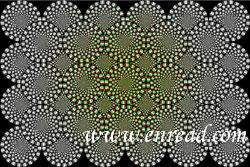明明在前进,却看到车轮在朝后转;画面上明明是一个三角形,从某个角度看过去却成了一条线。难道是眼睛出问题了?还是我们的错觉?

Humans can see into the future, says a cognitive1 scientist. It's nothing like the alleged2 predictive powers of Nostradamus(占卜者), but we do get a glimpse of events one-tenth of a second before they occur.
And the mechanism3 behind that can also explain why we are tricked by optical illusions.
Researcher Mark Changizi of Rensselaer Polytechnic4 Institute in New York says it starts with a neural5 lag(神经滞后) that most everyone experiences while awake. When light hits your retina(视网膜), about one-tenth of a second goes by before the brain translates the signal into a visual perception of the world.
Scientists already knew about the lag, yet they have debated over exactly how we compensate6, with one school of thought proposing our motor system somehow modifies our movements to offset7 the delay.
Changizi now says it's our visual system that has evolved to compensate for neural delays, generating images of what will occur one-tenth of a second into the future. That foresight8 keeps our view of the world in the present. It gives you enough heads up to catch a fly ball (instead of getting socked in the face) and maneuver9 smoothly10 through a crowd. His research on this topic is detailed11 in the May/June issue of the journal Cognitive Science,
That same seer(先知) ability can explain a range of optical illusions, Changizi found.
"Illusions occur when our brains attempt to perceive the future, and those perceptions don't match reality," Changizi said.
Here's how the foresight theory could explain the most common visual illusions - geometric illusions that involve shapes: Something called the Hering illusion, for instance, looks like bike spokes12 around a central point, with vertical13 lines on either side of this central, so-called vanishing point(没影点). The illusion tricks us into thinking we are moving forward, and thus, switches on our future-seeing abilities. Since we aren't actually moving and the figure is static, we misperceive the straight lines as curved ones.
"Evolution has seen to it that geometric drawings like this elicit14 in us premonitions(预感) of the near future," Changizi said. "The converging15 lines toward a vanishing point (the spokes) are cues that trick our brains into thinking we are moving forward - as we would in the real world, where the door frame (a pair of vertical lines) seems to bow out as we move through it - and we try to perceive what that world will look like in the next instant."
 收听单词发音
收听单词发音 



